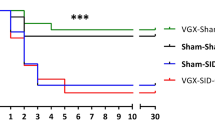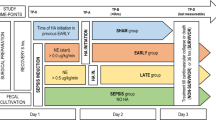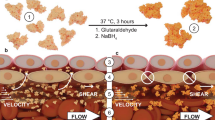Abstract
Purpose
Major surgery can modulate the immune system and by this the clinical course of following complications. Effects of minor surgical treatments on the immune system and septic complications are poorly understood.
Materials and methods
We investigated the effect of a minor surgical procedure—the implantation of an osmotic pump—on the outcome of experimental polymicrobial sepsis (colon ascendens stent-induced peritonitis, CASP) in mice.
Results
Animals with pumps implanted 3 days prior to CASP showed an attenuated clinical course of sepsis and increased survival. While measured serum cytokine levels were not affected by the minor surgical stress of pump implantation, splenocyte secretion of IFN-gamma in response to lipopolysaccharide was increased.
Conclusion
The early implantation of alloplastic material modulates the immune system and leads to an increased survival of a polymicrobial sepsis. Identifying the molecular nature of this effect might point the way to a new therapeutic approach to reduce sepsis mortality.






Similar content being viewed by others
References
Reinhart K, Brunkhorst F, Bone H, Gerlach H, Grundling M, Kreymann G, Kujath P, Marggraf G, Mayer K, Meier-Hellmann A, Peckelsen C, Putensen C, Quintel M, Ragaller M, Rossaint R, Stuber F, Weiler N, Welte T, Werdan K (2006) Diagnosis and therapy of sepsis: guidelines of the German Sepsis Society Inc. and the German Interdisciplinary Society for Intensive and Emergency Medicine. Anaesthesist 55(Suppl 1):43–56. doi:10.1007/s00101-006-1020-9
Koerner P, Westerholt A, Kessler W, Traeger T, Maier S, Heidecke CD (2008) [Surgical trauma and postoperative immunosuppression]. Chirurg 79:209–294
Chandra V, Nelson H, Larson DR, Harrington JR (2004) Impact of primary resection on the outcome of patients with perforated diverticulitis. Arch Surg 139:1221–1224. doi:10.1001/archsurg.139.11.1221
Branagan G, Finnis D (2005) Prognosis after anastomotic leakage in colorectal surgery. Dis Colon Rectum 48:1021–1026. doi:10.1007/s10350-004-0869-4
Maier S, Traeger T, Westerholt A, Heidecke CD (2005) Special aspects of abdominal sepsis. Chirurg 76:829–836. doi:10.1007/s00104-005-1066-2
Heidecke CD, Weighardt H, Hensler T, Bartels H, Holzmann B (2000) Immune paralysis of T-lymphocytes and monocytes in postoperative abdominal sepsis. Correlation of immune function with survival. Chirurg 71:159–165. doi:10.1007/s001040050028
Hensler T, Hecker H, Heeg K, Heidecke CD, Bartels H, Barthlen W, Wagner H, Siewert JR, Holzmann B (1997) Distinct mechanisms of immunosuppression as a consequence of major surgery. Infect Immun 65:2283–2291
Rosenbaum JT, Hartiala KT, Howes EL Jr, Goldstein IM (1985) Endotoxin tolerance diminishes certain antiinflammatory effects of endotoxin. Inflammation 9:297–308. doi:10.1007/BF00916278
Haslberger A, Sayers T, Reiter H, Chung J, Schutze E (1988) Reduced release of TNF and PCA from macrophages of tolerant mice. Circ Shock 26:185–192
Echtenacher B, Mannel DN (2002) Requirement of TNF and TNF receptor type 2 for LPS-induced protection from lethal septic peritonitis. J Endotoxin Res 8:365–369
Feterowski C, Weighardt H, Emmanuilidis K, Hartung T, Holzmann B (2001) Immune protection against septic peritonitis in endotoxin-primed mice is related to reduced neutrophil apoptosis. Eur J Immunol 31:1268–1277. doi:10.1002/1521-4141(200104)31:4<1268::AID-IMMU1268>3.0.CO;2-C
Zantl N, Uebe A, Neumann B, Wagner H, Siewert JR, Holzmann B, Heidecke CD, Pfeffer K (1998) Essential role of gamma interferon in survival of colon ascendens stent peritonitis, a novel murine model of abdominal sepsis. Infect Immun 66:2300–2309
Bolla G, Tuzzato G (2003) Immunologic postoperative competence after laparoscopy versus laparotomy. Surg Endosc 17:1247–1250. doi:10.1007/s00464-002-9135-9
Kalff JC, Schraut WH, Simmons RL, Bauer AJ (1998) Surgical manipulation of the gut elicits an intestinal muscularis inflammatory response resulting in postsurgical ileus. Ann Surg 228:652–663. doi:10.1097/00000658-199811000-00004
Rowland RR, Reyes E, Chukwuocha R, Tokuda S (1990) Corticosteroid and immune responses of mice following mini-osmotic pump implantation. Immunopharmacology 20:187–190. doi:10.1016/0162-3109(90)90033-B
Pross S, Newton C, Widen R, Klein TW, Friedman H, Spitzer JA (1992) Splenocyte blastogenesis suppressed in rats implanted with an osmotic pump. Life Sci 50:99–108. doi:10.1016/0024-3205(92)90291-V
Borovikova LV, Ivanova S, Nardi D, Zhang M, Yang H, Ombrellino M, Tracey KJ (2000) Role of vagus nerve signaling in CNI-1493-mediated suppression of acute inflammation. Auton Neurosci 85:141–147. doi:10.1016/S1566-0702(00)00233-2
Imbe H, Dubner R, Ren K (1999) Masseteric inflammation-induced Fos protein expression in the trigeminal interpolaris/caudalis transition zone: contribution of somatosensory–vagal–adrenal integration. Brain Res 845:165–175. doi:10.1016/S0006-8993(99)01913-7
Huston JM, Ochani M, Rosas-Ballina M, Liao H, Ochani K, Pavlov VA, Gallowitsch-Puerta M, Ashok M, Czura CJ, Foxwell B, Tracey KJ, Ulloa L (2006) Splenectomy inactivates the cholinergic antiinflammatory pathway during lethal endotoxemia and polymicrobial sepsis. J Exp Med 203:1623–1628. doi:10.1084/jem.20052362
Kessler W, Traeger T, Westerholt A, Neher F, Mikulcak M, Muller A, Maier S, Heidecke CD (2006) The vagal nerve as a link between the nervous and immune system in the instance of polymicrobial sepsis. Langenbecks Arch Surg 391:83–87. doi:10.1007/s00423-006-0031-y
Kemp JM, Kajihara M, Nagahara S, Sano A, Brandon M, Lofthouse S (2002) Continuous antigen delivery from controlled release implants induces significant and anamnestic immune responses. Vaccine 20:1089–1098. doi:10.1016/S0264-410X(01)00444-3
Toussaint JF, Dubois A, Dispas M, Paquet D, Letellier C, Kerkhofs P (2007) Delivery of DNA vaccines by agarose hydrogel implants facilitates genetic immunization in cattle. Vaccine 25:1167–1174. doi:10.1016/j.vaccine.2006.10.021
Acknowledgments
The expert technical assistance of Kathrin Mülling and Antje Müller is gratefully acknowledged. This work was supported by DFG-GK 840 “Host pathogen interactions” and by the Bundesministerium für Forschung und Technologie (BMBF-NBL3, FKZ 01ZZ0403, Modul E5).
Author information
Authors and Affiliations
Corresponding author
Additional information
Kessler and Ebker contributed equally to this work.
Rights and permissions
About this article
Cite this article
Kessler, W., Ebker, T., Koerner, P. et al. Implantation of alloplastic material increases survival of mice subsequently exposed to polymicrobial sepsis. Langenbecks Arch Surg 395, 157–162 (2010). https://doi.org/10.1007/s00423-009-0463-2
Received:
Accepted:
Published:
Issue Date:
DOI: https://doi.org/10.1007/s00423-009-0463-2




